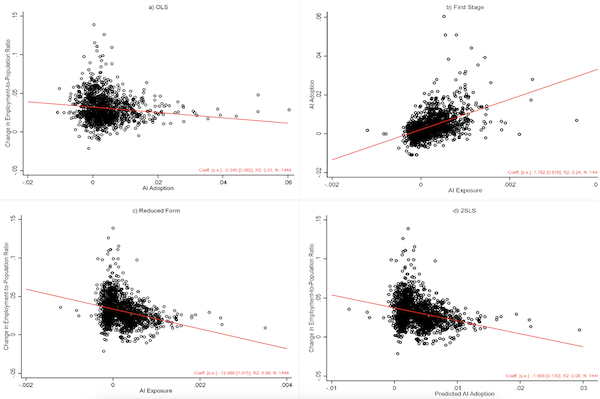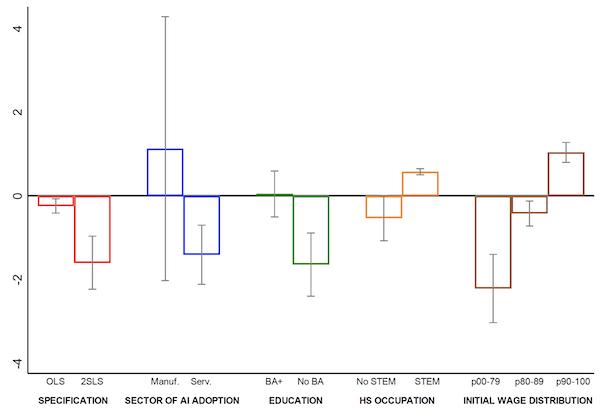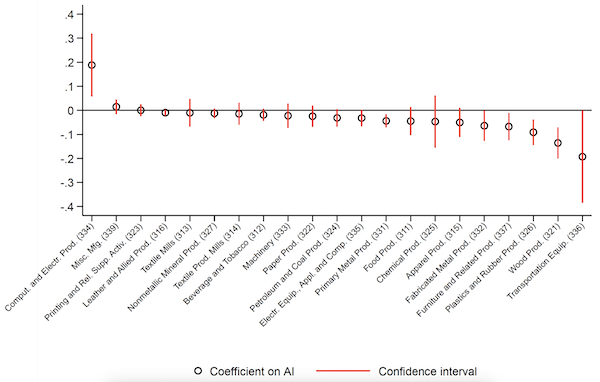Lamebert right here: Whaddaya know.
By Alessandra Bonfiglioli, Professor of Economics (on depart) at Queen Mary College Of London, Rosario Crinò, Professor of Economics at College Of Bergamo, Gino Gancia, Fellow, Worldwide Commerce and Regional Economics, and Ioannis Papadakis, Analysis Fellow at College Of Sussex. Initially revealed at VoxEU.
Harnessing the potential of synthetic intelligence has turn into one of many high priorities for policymakers around the globe. But, doing so first requires a radical understanding of the consequences of those applied sciences on labour markets. Utilizing information throughout US commuting zones over the interval 2000-2020, this column presents proof that AI adoption has lowered employment, besides in high-paying occupations and people requiring a level in STEM disciplines.
Synthetic intelligence (AI) is commonly seen as probably the most transformative and disruptive applied sciences of current instances (see early Vox columns by Baldwin 2018 and Bughin 2017). Because of enhancements in machine studying strategies and the rising availability of huge quantities of digital information, the final 20 years have witnessed an amazing improve in the usage of AI purposes, which embody internet engines like google, focused promoting, advice methods, generative or inventive instruments, and chatbots. A urgent coverage query is how these advances will have an effect on labour markets and particularly employment. On the one hand, clever instruments promise to boost human capabilities and create new demand for sure expertise (e.g. Brynjolfsson et al. 2023, McKinsey International Institute 2017). However, AI could surpass employees in decision-making duties and make them redundant, or it could gas automation (Acemoglu 2022, Acemoglu and Johnson 2023). Whether or not AI will complement or substitute employees is due to this fact an empirical query, for which there’s nonetheless little systematic proof.
In a current work (Bonfiglioli et al. 2023), we examine the employment impact of the early section of AI adoption, exploiting variation throughout US Commuting Zones (CZs) over the interval 2000-2020. Taking a broad definition of AI as algorithms utilized to large information, its diffusion began within the early 2000s and accelerated after 2010. Whereas our pattern predates the event of enormous language fashions resembling ChatGPT, it nonetheless covers the rise of the digital financial system and of all the most important corporations concerned in large information assortment, resembling Amazon, Google, and Fb.
Measuring AI Adoption Throughout US Commuting Zones
Our evaluation faces two challenges. The primary is that AI adoption is tough to measure, as there are not any official statistics obtainable to this point. Nevertheless, the usage of AI applied sciences requires employees with very particular programming expertise. Leveraging a novel part of the O*NET database – “Scorching Applied sciences” – we classify AI-related occupations as these whose job postings most often require software program used for machine studying and information evaluation. Our baseline classification of AI-related occupations includes 19 titles, resembling information scientists, pc programmers, software program builders, and internet designers. Then, we detect AI adoption from the expansion within the relative significance of those AI-related occupations. A second problem in figuring out causal results is that AI adoption is perhaps correlated with different shocks which will have an effect on employment. To beat this drawback, we use a shift-share instrument, AI publicity, that mixes industry-level AI adoption for the US with pre-adoption CZ-level employment shares throughout industries. This permits us to establish CZs extra uncovered to AI as these specialised in industries that skilled quicker progress in AI-related occupations nationwide.
Between 2000 and 2020, the employment share of AI-related occupations has virtually doubled within the US, rising from 0.14% to 0.20%. Most of this improve has taken place after 2010. There are sizable variations within the diffusion of AI applied sciences throughout industries. AI adoption is most prevalent within the service sector, particularly in superior branches resembling data, skilled, scientific and enterprise companies. Additionally it is vital in some utilities, resembling electrical energy, and in some areas of the general public sector, resembling nationwide safety and worldwide affairs. Conversely, AI adoption continues to be restricted in manufacturing. This function distinguishes AI adoption from the usage of industrial robots, which is generally concentrated within the manufacturing sector (Acemoglu and Restrepo 2020).
Determine 1 presents color maps displaying how AI adoption (panel a) and AI publicity (panel b) range throughout US CZs, with darker colors representing greater ranges of adoption or publicity over the pattern interval. Detrimental values are very uncommon (solely 6% of CZs), implying that the deployment of AI applied sciences has been a widespread phenomenon within the US over the past 20 years. Apparently, our measure of AI adoption (panel a) could be very efficient at capturing the diffusion of AI each in anticipated locations resembling Boston, Seattle, and Silicon Valley, and in new high-tech hubs resembling Boulder, Bozeman, and Salt Lake Metropolis. Our measure of AI publicity (panel b) removes the variation in AI adoption that’s extra more likely to be pushed by contemporaneous CZ-level shocks, which can confound the estimation.
Determine 1 AI Adoption and AI Publicity in US Commuting Zones
Supply: US Census and American Group Survey.
Notes: The highest map plots the common worth of the measure of AI adoption in every CZ between the many years 2000-2010 and 2010-2020. The underside map plots the corresponding values of the measure of AI publicity.
The Detrimental Impact of AI Adoption on Employment
Determine 2 supplies a graphical illustration of our empirical technique and primary outcomes. The dots in every of the 4 scatter plots signify observations for every CZ and decade (2000-2010 and 2010-2020), whereas the pink line is the linear regression line. Panel a (OLS) paperwork a damaging correlation between AI adoption and the decadal change within the employment-to-population fee on the CZ degree. Panel b (first stage) confirms that AI publicity is a robust predictor of AI adoption and, thus, a robust instrument for the deployment of those applied sciences. Panel c (lowered kind) reveals that AI publicity is strongly negatively correlated with employment progress. Lastly, panel d (2SLS) plots the connection between AI adoption, as predicted by AI publicity, and the decadal change within the employment fee, highlighting a robust damaging (causal) impact of AI adoption on employment progress. General, these graphs present that CZs specialised in sectors experiencing a growth in AI-related employment had stronger charges of AI adoption, which in flip prompted them to undergo a relative slowdown in employment. Quantitatively, our estimates indicate that if the CZ with common AI adoption over the pattern interval had hypothetically had no adoption in any respect, its employment fee would have grown by 0.6 share factors extra.
Determine 2 AI Adoption, AI Publicity and Employment in US Commuting Zones

Notes: The estimation pattern consists of 722 CZs noticed over 20 years, 2000-2010 and 2010-2020. In every plot, an commentary is a CZ x decade pair. Predicted AI Adoption is the fitted worth of the measure of AI adoption from the first-stage regression in Plot b).
These outcomes are sturdy to controlling for a number of further labour market shocks, resembling import competitors from China (Autor et al. 2013), the adoption of commercial robots (Acemoglu and Restrepo, 2020), and the elevated utilization of ICT. Additionally they maintain when utilizing various definitions of AI-related occupations and when controlling for outliers in varied methods.
Determine 3 reveals how the connection between AI adoption and employment progress varies throughout specs. The determine conveys three primary outcomes. First, the impact of AI adoption is far stronger when AI adoption is instrumented utilizing AI publicity (2SLS versus OLS specification), suggesting that confounding elements are likely to masks the damaging influence of AI on employment. Second, the impact of AI is pushed by adoption within the service sector, the place the deployment of those applied sciences is extra prevalent. Third, employees with no faculty diploma are essentially the most negatively affected by AI adoption. Conversely, the one employees to profit from AI adoption are these in occupations requiring a STEM diploma and people within the high 10% of the earnings distribution.
Determine 3 Heterogeneity

Notes: The determine experiences estimated coefficients and 90% confidence intervals on the measure of AI adoption from totally different specs. The estimation pattern consists of 722 CZs noticed over 20 years, 2000-2010 and 2010-2020.
Our outcomes additionally present that the damaging impact of AI adoption will not be restricted to the service sector but additionally extends to employment in manufacturing, the place the usage of these applied sciences continues to be restricted. Particularly, the manufacturing sector accounts for nearly 45% of the general influence of AI adoption on employment, towards 60% for the service sector. To make clear the mechanism underlying these spillovers, Determine 4 experiences the estimated results of AI adoption on employment within the totally different manufacturing industries. The determine reveals that employees in industries characterised by excessive automation depth, resembling transport tools and wooden merchandise, are particularly arduous hit. This implies that AI adoption in companies could, in truth, be used for the automation of jobs in manufacturing.
Determine 4 AI Adoption and Employment in Particular person Manufacturing Industries

Notes: The estimation pattern consists of 722 CZs noticed over 20 years, 2000-2010 and 2010-2020.
Conclusions
Current enhancements within the subject of AI have triggered a lot hype about the way forward for work. Whereas no person can predict the precise course that new improvements and purposes will take, we expect that you will need to begin from understanding the implications that these applied sciences have already had. Our outcomes level towards sturdy damaging results of AI adoption on employment for many employees and sectors. Whereas extra micro-level proof is required to exactly establish the mechanism by means of which these damaging results unfold, our proof is nonetheless according to the view that AI is contributing to the automation of jobs and to widening inequality.
References obtainable on the authentic.





